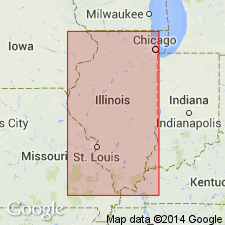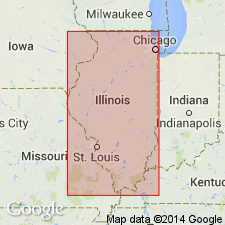
- Usage in publication:
-
- Matson Member
- Modifications:
-
- Original reference
- Dominant lithology:
-
- Dolomite
- Limestone
- AAPG geologic province:
-
- Ozark uplift
- Illinois basin
Summary:
Pg. 61-62, 228. Matson Member of Joachim Dolomite of Ancell Group (new). Name proposed for member of Joachim Dolomite [also called Joachim Formation in text]. Relatively pure, gray to light-brown laminated thick-bedded algal dolomite that grades southward into dark-brown limestone. In type section, a 17-inch unit 17 inches below top of Matson consists partly of fine-grained, faintly cross-bedded detrital dolomite. Average thickness 30 feet; thicker in some wells. Overlies Defiance Member (new); underlies Metz Member (new). Age is Middle Ordovician (Champlainian).
Type section: quarry and bluff exposures in north bluff of Missouri River Valley, 0.5 mi west of village of Matson, in NE/4 NE/4 NE/4 sec. 4 (projected), T. 44 N., R. 2 E., Augusta quadrangle [Labadie 7.5-min quadrangle], St. Charles Co., eastern MO. Named from village of Matson. Also well exposed in Metz type section.
Source: US geologic names lexicon (USGS Bull. 1350, p. 476); supplemental information from GNU records (USGS DDS-6; Reston GNULEX).

- Usage in publication:
-
- Matson Member
- Modifications:
-
- Overview
- AAPG geologic province:
-
- Illinois basin
Summary:
In IL, Matson Member of Joachim Dolomite is exposed only at West Point Landing in Calhoun Co., where it is 21 ft thick. It is about 30 ft thick elsewhere in outcrop area, but in subsurface of IL, it is commonly 15 to 40 ft thick. Differs from the other members of Joachim Dolomite in being relatively pure, brown, finely porous dolomite that generally appears to be massive but finely laminated, the laminae separated by thin films of dark-brown clay. Locally contains a few beds of lithologies found in Defiance and Augusta Members. Appears to be largely algal in origin. Ostracodes appear locally in basal beds; marine fauna with corals, brachiopods, and trilobites has been observed at one locality near Zell, MO. Age is Middle Ordovician (Champlainian, Blackriveran).
Source: GNU records (USGS DDS-6; Reston GNULEX).
For more information, please contact Nancy Stamm, Geologic Names Committee Secretary.
Asterisk (*) indicates published by U.S. Geological Survey authors.
"No current usage" (†) implies that a name has been abandoned or has fallen into disuse. Former usage and, if known, replacement name given in parentheses ( ).
Slash (/) indicates name conflicts with nomenclatural guidelines (CSN, 1933; ACSN, 1961, 1970; NACSN, 1983, 2005, 2021). May be explained within brackets ([ ]).

